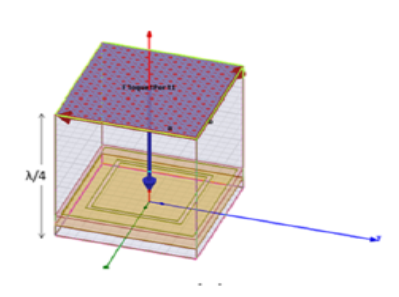


Indian Journal of Science and Technology
DOI: 10.17485/IJST/v15i18.1843
Year: 2022, Volume: 15, Issue: 18, Pages: 881-891
Original Article
Sangeeta Shekhawat1*, Sudhanshu Singh1, Sanjay Kumar Singh1
1Amity School of Engineering & Technology, Amity University Rajasthan, Jaipur303002, NH11 C, Jaipur, Kant Kalwar, Rajasthan, India
*Corresponding Author
Email: *[email protected]
Received Date:01 December 2022, Accepted Date:13 April 2022, Published Date:25 May 2022
Background/Objectives: Flexible electronics have paved the way for Wireless Body Area Networks (WBAN). The main challenge in accommodating such applications is reducing the impact of radiation on the human body. The presence of body tissues may affect WBAN devices such as wearable sensors and wearable antennas, so reducing back radiations becomes an important task. Methodology: When a microstrip patch antenna is placed on a human body, the artificially formed Electromagnetic Band Gap (EBG) surface mimics the property of a Perfect Magnetic Conductor (PMC) rather than the conventional Perfect Electrical Conductor (PEC). Findings: In this work, the unique property of the EBG surface beneath the patch antenna creates a zero phase shift at the resonance, which improves the antenna’s performance and reduces back radiations as well. The proposed EBG surface structure is the simplest square-shaped structure with no conductor connections Via patch (Via-less). Novelty: The EBG structure designed and presented in this paper has zero reflections for the dual-band of operations. The resonance frequency of 2.45GHz and 5.5 GHz has been designed for the absorption of 80% and 65% respectively. This level of absorption has not yet been reported in the literature. The newly formed EBG cell integrated with the patch antenna and its performance improvements has been shown. The analysis shows that the EBG enhances the return loss by 20.35 % and gain enhances by 16.44 %, on textile materials with the advantage of most simplex EBG cell construction.
Keywords: EBG; PMC; PEC; Wearable Microstrip Patch Antenna; WBAN
© 2022 Shekhawat et al. This is an open-access article distributed under the terms of the Creative Commons Attribution License, which permits unrestricted use, distribution, and reproduction in any medium, provided the original author and source are credited.
Published By Indian Society for Education and Environment (iSee)
Subscribe now for latest articles and news.